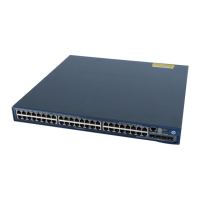61
Figure 17 Topology of the final calculated spanning tree
A
B C
Root port
Designated port
Root bridge
Normal link
Blocked link
Blocked port
The BPDU forwarding mechanism in STP
STP forwards configuration BPDUs following these guidelines:
Upon network initiation, every switch regards itself as the root bridge, generates configuration
BPDUs with itself as the root, and sends the configuration BPDUs at a regular hello interval.
If the root port received a configuration BPDU and the received configuration BPDU is superior to the
configuration BPDU of the port, the device increases the message age carried in the configuration
BPDU following a certain rule and starts a timer to time the configuration BPDU while sending this
configuration BPDU through the designated port.
If the configuration BPDU received on a designated port has a lower priority than the configuration
BPDU of the local port, the port immediately sends its own configuration BPDU in response.
If a path becomes faulty, the root port on this path no longer receives new configuration BPDUs and
the old configuration BPDUs will be discarded because of timeout. The device generates a
configuration BPDU with itself as the root and sends the BPDUs and TCN BPDUs. This triggers a new
spanning tree calculation process to establish a new path to restore the network connectivity.
However, the newly calculated configuration BPDU cannot be propagated throughout the network
immediately, so the old root ports and designated ports that have not detected the topology change
continue forwarding data along the old path. If the new root ports and designated ports begin to forward
data as soon as they are elected, a temporary loop might occur.
STP timers
The most important timing parameters in STP calculation are forward delay, hello time, and max age.
Forward delay: Specifies the delay time for port state transition. A path failure can cause spanning
tree re-calculation to adapt the spanning tree structure to the change. However, the resulting new
configuration BPDU cannot propagate throughout the network immediately. If the newly elected root
ports and designated ports start to forward data immediately, a temporary loop will likely occur. For
this reason, as a mechanism for state transition in STP, the newly elected root ports or designated
ports require twice the forward delay time before they transit to the forwarding state to ensure that
the new configuration BPDU has propagated throughout the network.
Hello time: Specifies the time interval at which a device sends hello packets to the surrounding
devices to ensure that the paths are fault-free.
Max age: Determines whether a configuration BPDU held by the device has expired. A
configuration BPDU beyond the max age is discarded.

